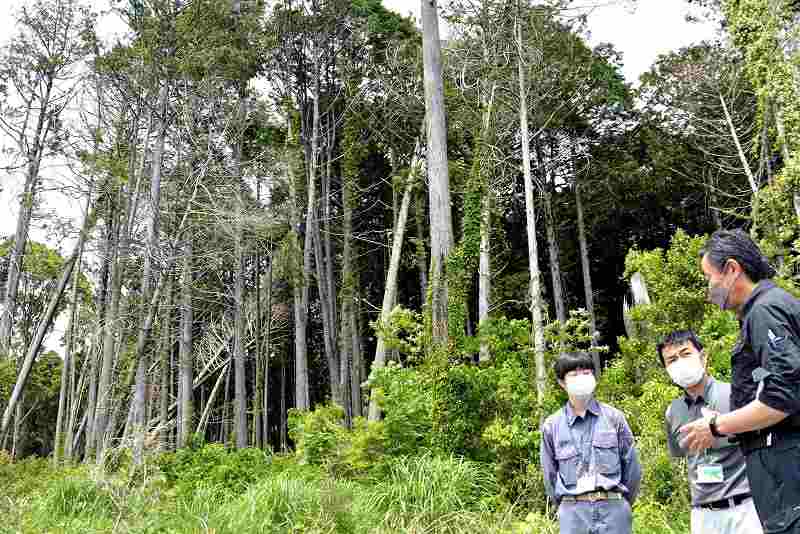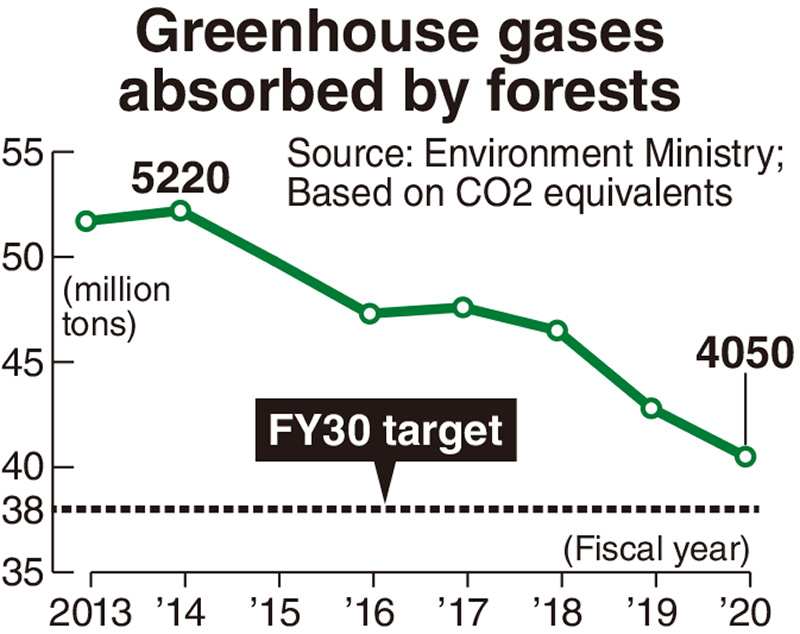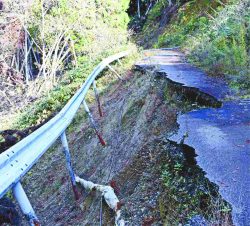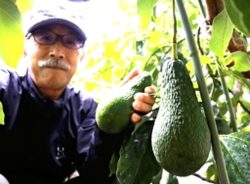
Officials of the Sammu city government make the rounds of forests left uncared for in Sammu, Chiba Prefecture, in May.
1:00 JST, July 18, 2022
Although the forest area in Japan hardly changed, the amount of greenhouse gases absorbed by forests fell by as much as 20% in the six years through to fiscal 2020.
The decline was primarily due to an increase in the proportion of old trees, which photosynthesize less than younger ones, as the country’s forestry industry declines. Unless the amount of CO2 absorbed by forests is kept from falling too sharply, there is little hope for achieving the government’s target greenhouse gas reductions.
Half of trees over 50
The city of Sammu, located in the northeast of Chiba Prefecture, is known for high-quality Japanese cedar called “Sambu sugi.”
Stepping into one of its forests, one sees trees with narrow trunks and others that stand dead.
“Since there’s been no thinning, their growth stopped while their trunks were still narrow. It is time for trees to be cut down. But they are left uncared for due to low demand for domestic timber and a shortage of forestry workers,” said an official of the city government with a sigh.
According to the city government, its forest area totals 3,900 hectares, occupying one-quarter of the total area of the city. Of the forest area, only 12% is covered by management plans, such as for thinning and cutting-down the trees.
In 2019, Typhoon No. 15 brought many trees down with strong winds, causing a large-scale power outage in parts of the city for about two weeks.
As trees in man-made forests in Japan were mostly planted between the 1950s and 1970s, and they are now more than 50 years old, the age at which they are suitable for cutting. But there has been an increase in the number of cases where these old trees are left to stand untended.
According to the Forestry Agency, the area of man-made forests in Japan totals over 10 million hectares, almost unchanged since the 1980s. But the proportion of those trees age 51 or older grew from 2.15 million hectares, or 20% of the total, in 2007 to 5.1 million hectares, or 50% of the total, in 2017.

Reduction target
The aging of forests will also be problematic in preventing global warming, as older trees do not photosynthesize as much as younger ones, absorbing less CO2.
According to the Environment Ministry, due to the aging of Japan’s forests, the amount of CO2 absorbed by them fell from 52.2 million tons in fiscal 2014 to 40.5 million tons in fiscal 2020, dropping by as much as 22% in just six years. This amount is equivalent to the annual emissions of CO2 made by 4 million households.
The government’s target greenhouse gas reductions have been calculated as net emissions, or the emissions from human activities minus the amount absorbed by forests. If the aging of the forests continues at the current pace, it is highly likely that within a few years the amount of CO2 absorbed by the forests will fall below 38 million tons, the amount of forest-absorbed CO2 presumed by the government in its fiscal 2030 reduction target (which aims to cut greenhouse gas emissions by 46% compared to fiscal 2013).
A senior official at the Forestry Agency expressed alarm, saying, “Somehow or other, we have to stop the fall [of the amount of CO2 absorbed by forests].”
Forest environment tax
There seem to be no quick solutions for the decline of the nation’s forestry industry, caused by such intertwined factors as the import of low-priced foreign lumber and the aging of those working in forestry. But steady efforts to put the country’s forestry management back on a sound footing are also underway.
The central government is to introduce a forest environment tax, mostly aimed at preventing global warming, in fiscal 2024. This is to be collected as a national tax of ¥1,000 per person per year and added to the individual resident tax. The government will allocate the tax revenue, projected to be about ¥60 billion a year, to local governments, which will then use the money as part of expenses required for improving their forests.
The city government of Maniwa, Okayama Prefecture, is trying to kill two birds with one stone by making use of its rich forest resources to increase the amount of CO2 absorbed by forests and reduce greenhouse gas emissions.
The city government will actively use the timber from locally thinned forests as fuel at a woody biomass power plant operated by a new electric power company financed by the city. By generating power without using fossil fuels, it can reduce greenhouse gas emissions.
Part of the profit made through the sale of electricity to these owners will be allocated to owners of mountain forests to encourage them to thin out their forests or plant trees. By doing this, the Maniwa government is aiming to rejuvenate the forests and increase the amount of greenhouse gases being absorbed.
An official of the city government said, “It is essential to appropriately circulate forest resources to realize the decarbonization of our society.”
"Society" POPULAR ARTICLE
-

M4.9 Earthquake Hits Tokyo, Neighboring Prefectures
-

Israeli Tourists Refused Accommodation at Hotel in Japan’s Nagano Pref., Prompting Protest by Israeli Embassy and Probe by Prefecture
-

M7.5 Earthquake Hits Northern Japan; Tsunami Waves Observed in Hokkaido, Aomori and Iwate Prefectures
-

Tsukiji Market Urges Tourists to Avoid Visiting in Year-End
-

M5.7 Earthquake Hits Japan’s Kumamoto Pref., Measuring Upper 5 Intensity, No Tsunami Expected
JN ACCESS RANKING
-

Keidanren Chairman Yoshinobu Tsutsui Visits Kashiwazaki-Kariwa Nuclear Power Plant; Inspects New Emergency Safety System
-

Tokyo Economic Security Forum to Hold Inaugural Meeting Amid Tense Global Environment
-

Imports of Rare Earths from China Facing Delays, May Be Caused by Deterioration of Japan-China Relations
-

University of Tokyo Professor Discusses Japanese Economic Security in Interview Ahead of Forum
-

Japan Pulls out of Vietnam Nuclear Project, Complicating Hanoi’s Power Plans
























